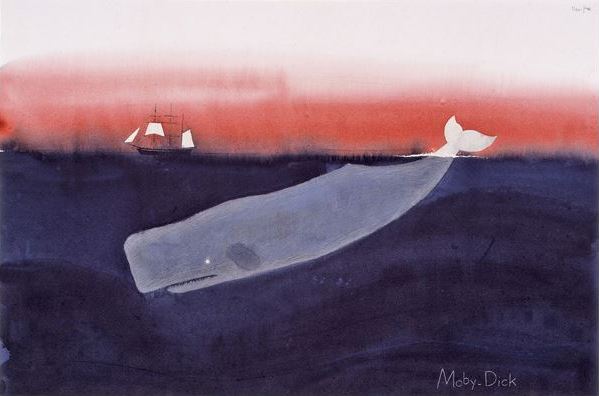 Claus Hoie, Moby Dick. Watercolor 21 x 29.
Claus Hoie, Moby Dick. Watercolor 21 x 29.
Moby Dick and Modern Architecture
I’m a firm believer that the arts should inform each other, and that the written arts are a great complement to the visual arts. But I was not prepared for how deeply my recent reading of Moby Dick would affect my views on Modern architecture. To be fair, I had already been struggling with my doubts regarding the recent revival of modern residential fashions. But I could not put those doubts into words, or explain why I found their rote minimalism so unconvincing. Then, about two thirds of the way through my reading of Moby, I woke up with a surprising phrase running through my head: “Moby Dick is really better than Mies!”
If you plan on reading Moby Dick, I would recommend that you do so with friends. And I would recommend that you plan to do so in at least four sessions, spaced out every 150 pages or so. There’s just so much to discuss. As soon as we started we realized that a few of us had already read Moby, and that it was feeling very different the second time around. For instance, I had first read Moby in college and it had seemed like an adventure to me then. But I was on an adventure then too. Reading it now, thirty-five years later, the book appeared much darker. And Ishmael, far from an adventurer, seemed like a ghost to me, lacking physicality. How could I have missed that the first time?
Our subsequent sessions proved similarly profound, as we each developed our individual interpretations. One friend saw Moby as an indictment of American industrial expansion, while another felt it attempted a post-racial perspective. A third friend saw it as an environmental critique, while a more religious friend found Melville’s intent blasphemous: “to literally pierce the Christian idea of God,” he said. (The White Whale, of course). Clearly, we each saw the book through our contemporary interests. And while I harbored my own pet view I was amazed at how the text seemed to support each interpretation. And so I came to see that the differences in our interpretations were also measurements of the differences in us. And my admiration for Melville’s art grew.
All the time I was reading Moby the architect in me was watching closely. And subconsciously a parallel project started taking shape in my architectural imagination. It was inspired by the questions, “What if Moby Dick were actually a great house? What might its architecture be like?” I listed its characteristics. It would be old, of course, but not historical; it was too present for that. And while I could not imagine its exact style I knew it would be modern, though not Modernist. After all, Melville had practically invented the modern novel. And its architecture would be captivating, yet impossible to categorize. Like the book itself, the architecture for a house comparable to Moby would have to be forever delicious and indecipherable.
As I continued to imagine the architecture of Moby, comparisons to the architecture of Mies van der Rohe became unavoidable. Such is the influence of Mies on what we call modern today. And I came to recognize the following:
- Where Mies is minimal, Moby is epic.
- Where Mies strives for clarity, Moby creates ambiguity.
- Where Mies is restrained, Moby takes risks.
- Where Mies creates rules, Moby exercises license freely.
- And where Mies minimizes the individuality of the user, Moby allows each reader to complete the work for her/himself!
There’s a lot to think about in the comparisons above, but the line that stands out for me is the last one. If architecture is about values, and it must be, this line seems to describe a fundamental choice in our art. And it’s a case that literature can make more ably than architecture: the case for the Reader’s critical role in completing the Work. Viewed another way, to remain relevant for over a hundred and fifty years Melville’s book has needed to attract generations of new readers. And given the challenging nature of this read, new readers like me would never have taken it up if it didn’t engage us in OUR meaning too.
Now compare that idea with the words of one of Mies’ own clients, Fritz Tugendhat, who in 1931 said of his house, “It is true that one cannot hang any pictures in the main space, in the same way that one cannot introduce a piece of furniture that would destroy the stylistic unity of the original furnishings—but is our ‘personal life repressed’ for that reason?” One suspects that he knew that it was, even if he was making this tradeoff willingly.
But the point of this writing is not to bash Mies, or to point out known criticisms of minimal architecture. My goal instead is to provide some perspective on the choices we all face as we design new houses. And for me they now include new questions. For instance, do we believe in an architecture that values clarity over ambiguity? And if so, why? And do we value rules over license? And if so, why? Ultimately, what I think literature can offer to visual artists comes down to new words. And for architects, new words are the elusive tools we may need to move our art into the next century.
— By James Merrell · January 27, 2017
~~~~~~~~~~~~~~
James Merrell Architects
66 Main Street, Sag Harbor, NY 11963
—————————–
Click here to view James Merrell / Journal: A Laboratory for Architectural Design
Click here to view James Merrell / Journal: Discerning the Rational from the Modern in Architecture
___________________________________________________
